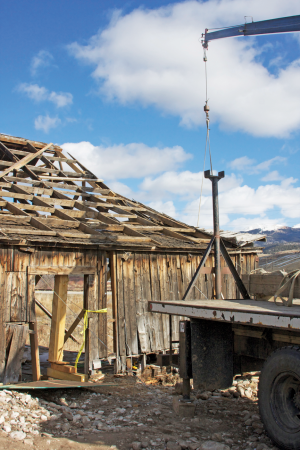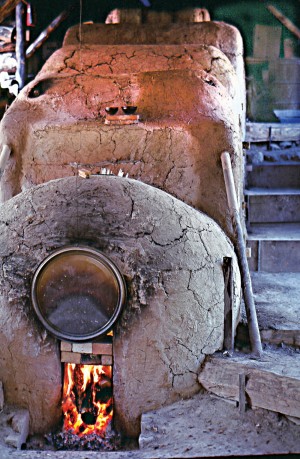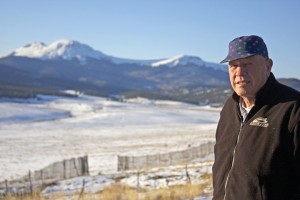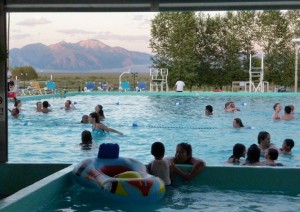By Michael Conlin
Editor’s note: This article first appeared in Colorado Preservationist magazine and is reprinted by permission.
A Brief History of Leadville
In April of 1860, a small band of wizened prospectors, veterans of the 1849 California Gold Rush, stooped patiently over the bone chilling cold waters of a small tributary stream not far from the current day Hayden Ranch. Patiently they searched the swirling waters of their gold pans for the “color” that would surely bring them fortune.
The tedium was broken when one of the prospectors, Abe Lee, rose stiffly from the bed of the creek and exclaimed, “Boys, I just found all of California in this here pan!” With those words, the rush was on, and the legacy of one of Colorado’s richest and bawdiest mining camps was born.
Word of the rich strike spread like wildfire, and soon the sounds of picks and shovels striking the hard Rocky Mountain earth rang from every tributary in the basin. By July of 1860, over 8,000 miners and prospectors fanned out over the length and breadth of the Upper Arkansas River Valley, spilling over the mountain passes into the valleys of the Eagle, Gunnison, and Roaring Fork Rivers in search of precious metals.
Beginning as a crude assortment of mud-roofed cabins and tents, a community aptly named Oro City, Spanish for gold, sprang up seemingly overnight. Millions of dollars in placer gold were extracted from the glacial alluvium of gulches with names like California, Nugget and Stray Horse, but the color soon panned out, and many miners moved on to the next strike.

The mining camp might have become just another Colorado ghost town gracing the pages of modern history books, had it not been for Alvinus Wood’s fortuitous discovery in 1873, that the black sands that had clogged the sluice boxes and gold pans of the early gold miners, was in fact lead carbonate, fabulously rich in silver.
During its second heyday in the 1880s and early 90s, the mining camp, now renamed Leadville, made its fortune extracting the rich veins of silver that lay buried beneath the hills east of town. Assays approaching and sometimes exceeding 10,000 troy ounces of silver to the ton of ore yielded extraordinary wealth, creating one of the most ornate and modern communities in the west, while establishing the fortunes of such historic figures as Meyer Guggenheim, Charles Boettcher, David May, David Moffett, and H.A.W. Tabor.
During this second “boom” cycle, Leadville boasted a population of over 30,000; was among the first communities in Colorado to have electrical power; and was considered as a possible site for the State Capital.
Shadowy characters from Colorado’s early history, including Doc Holiday, the James Gang, the Younger Brothers, and “Soapy” Smith frequented Leadville’s flourishing brothels, bars, and gambling houses, while the new wealth of the “Silver Kings” built grand hotels and opera houses, drawing headliners like Oscar Wilde and Harry Houdini to the frontier town. While Horace and Baby Doe Tabor entertained Heads of State, the “Unsinkable Molly Brown” struggled to shed her commoner’s past to gain entry into Colorado’s elite society. Leadville staked its claim in history as Colorado’s “Silver City.”
The Role of Agriculture
While the vast mineral resources of the Leadville Mining District were the driving force for settlement of the central Colorado Rockies, the literal “horsepower” to support the early mining industry was provided by the horses, burros, oxen and mules that carried the prospectors’ packs, pulled the stagecoaches, ore and freight wagons, and skidded the timber from the forest. Prior to the arrival of the first train, virtually everything that came into, passed through, or left the mining camp, did so riding on the backs of beasts of burden.
If beasts of burden provided the literal horsepower of the day, then it was the hay that fed the livestock that fueled the mining boom. The problem was that the sparse mountain grasses of the mining camp, at an elevation typically exceeding 10,000 feet, could hardly support a family of chipmunks, much less thousands of toiling “hay burners.”
The solution lay in the lush bottomlands of the Arkansas River Valley, where abundant water and rich soils supported a luxurious mantle of the hay and cool season grasses that were needed to fuel the growing mining industry. Astute ranchers quickly homesteaded the lands along the river bottom to raise and harvest the lucrative crop.

The Hayden Ranch
What we refer to as the Hayden Ranch today was first called the Elkhorn Ranch, and records of its operations date back to 1860. It is located on an ancient terrace of the Arkansas River, some 10 miles south of Leadville. Perched above a shallow water table, this broad expanse of verdant grasslands is nestled between the Sawatch and Mosquito Ranges of the Rocky Mountain Cordillera, at the base of Mount Elbert, Colorado’s highest peak. Its eastern boundary is formed by the braided channel of the Arkansas River. The meandering course of Box Creek, with its headwaters high on the snow covered slopes of Mount Elbert, flows lazily across the ranchlands, recharging the underlying aquifer and supporting rich meadows and wetlands.
The ranch passed through many famous hands in Leadville’s early “boom” years. In 1864, part interest in the ranch was purchased from Mr. John Harrington by Father John Dyer, Colorado’s “Snowshoe Itinerant,” and renamed the Dyer and Harrington Hay Ranch. Besides spreading the gospel to the remote mining camps, Father Dyer is best known for delivering the mail between Fairplay and Leadville, which required traversing the treacherous 13,000 foot elevations of Mosquito Pass on nine foot long “snowshoes,” in the dead of winter.
In 1868, Father Dyer sold a one-half interest to the Ranch to his son, Judge Elias Dyer. Judge Dyer was murdered by vigilantes in his own courtroom in Granite in 1875 during the infamous “Leadville Wars,” a violent dispute triggered by the murder of John Harrington over ranch water rights.
In 1871 the Ranch was sold to a mercantile owner by the name of Charles Mater, one of Leadville’s founding fathers and a member of its first Board of County Commissioners. Mater also chartered Leadville’s First National Bank and founded the Leadville Chamber of Commerce. Mater sold the Ranch to Olive and Francis Hayden in 1872. The property was held within the same family for more than six decades and still bears their name today.
The Hayden Ranch is a study in evolution, surviving by changing to meet the demands and economic shifts inherent to the boom and bust cycles typical of mining communities.
The Hayden Ranch was initially operated as a hay ranch from 1860 through the early 1890s, when the Silver Panic of 1893 dropped the bottom out of the silver market, plummeting Leadville once again into the classic “bust” cycle. With the advent of electricity and arrival of the automobile shortly thereafter, the horse drawn era began its steady decline into obscurity, and the hay market never fully recovered. To survive the hard times the Hayden family had to change or perish. They turned to grazing cattle, and harvested hay to “winter over” the livestock so that they could be sold as “long yearlings” in the more profitable spring market. To store the hay, tend to the cattle and house the ranch hands, they built many of the structures that today constitute the Hayden Homestead National Historic Site.
In 1919, the Hayden’s turned the operation of the Ranch over to their son-in-law, John Weir. Inside of the main hay barn Weir installed a Loeffel water turbine to power a stationary hay baler, mechanical shop, and sawmill, which allowed the Ranch to process and package their products for sale. A ranch spur off of the Denver and Rio Grande rail line, known as the Weir siding, allowed them to transport their cattle and agricultural products outside of the depressed local market. The Ranch survived where many others faltered or failed.
The Ranch was sold to the Callahan Construction Company in 1933, and was used briefly in 1939 as part of the U.S. Army Remount Service to breed choice horses for the Calvary. World War II rendered the horse soldier obsolete, however, and the program was dropped. Callahan instituted many new technologies for cattle breeding and rearing, and ran a successful year-round livestock business for the next 14 years.
Callahan sold the ranch in 1947, and since that time it has been used primarily for seasonal cattle grazing. With no need to store winter hay, or to house the numerous ranch hands required to raise, irrigate, and harvest the grasses, the buildings were eventually taken out of active use and began the inevitable process of deterioration.
Speculation
In the 1960s, encouraged by the successes of the Aspen and Vail ski areas, a consortium of investors acquired the Hayden and several other ranches in Lake County, convinced that the ski industry would logically spill over into the Arkansas River Valley. Lands near the base of Mount Elbert were subdivided into over 1,200 building lots, and a speculative condominium complex called the Pan Ark Lodge (today re-named the Moosehaven Condominiums) was constructed just north of the Hayden Homestead.
A circular configuration of stone faced columns still stands where the base of the gondola to the summit of Mount Elbert was to be built. It was a dream that was never to come to fruition.
In the summer of 1997 the investment consortium decided to liquidate its holdings, and some 7,000 acres of historic ranch land, including the Hayden Ranch, were simultaneously dumped on the real estate market.
Citizens of Lake County raised the alarm that development of the ranches into low density “Ranchettes,” as has become common across the American west, could lead to a loss of the sense of uncluttered open space that distinguishes the Arkansas Valley, degradation of the scenic viewsheds guarding Colorado’s highest peaks, interruption of essential wildlife migration routes, fragmentation of critical winter wildlife habitat, and a severance of the tangible links to our ranching heritage.
At the same time, Lake County was struggling from the loss of approximately 80% of its assessed valuation due to the closure of the Climax Mine, with no appreciable decrease in demand for basic services. In a deficit spending position, with limited manpower and planning budget, there was little that the county could do to respond to these public concerns on their own. The prospect of losing local control over growth, coupled with the potential loss of the natural, historic, and cultural resource values that drew many residents and visitors to Lake County, rallied the community to action.
The Beginning of Hayden’s Preservation
In early 1998 the Hayden Ranch was optioned by the City of Aurora, whose primary interest was in securing the ranch water rights to meet their existing and future municipal needs. In an unprecedented move, the city approached the Lake County Commissioners with the unique offer to work cooperatively in determining how the community wanted to see the surplus lands of the Hayden Ranch used.
The Board of Commissioners seized the opportunity and assembled a diverse mix of stakeholders with an interest in the future of the Upper Arkansas River Basin. The partnership that would result from the effort would come to be known as the Lake County Open Space Initiative (LCOSI), and would grow to include some 25 federal, state, and local agencies, municipalities, citizen groups and organizations. The organization is bound by a memorandum of understanding, administered by Colorado Mountain College.
The first order of business was a community poll, conducted for LCOSI by Colorado Mountain College, which specifically asked whether survey participants supported the acquisition of ranch lands along the Arkansas River for the preservation of open space and the creation of parks. An overwhelming 91% of respondents indicated support, providing a strong public mandate to protect the lands as open space.
Based on that mandate, LCOSI adopted a mission statement that prioritized the preservation and stewardship of land and water resources for open space, wildlife, historic preservation, public education, smart growth and outdoor recreation.
Over the course of the next seven years, LCOSI successfully placed over 8,000 acres of land under a single Ecosystem Management Plan. Ecosystem Management Planning views the land in much the same way as wildlife does, as an interwoven matrix of forage, water and cover, rather than as a series of political or jurisdictional property lines, and seeks to manage the land and its resources to their highest and best use, regardless of man imposed boundaries.
The LCOSI Ecosystem Management Plan is a voluntary, consensus document, developed through cooperation between the agency land owners and the local community to cross jurisdictional lines in establishing management emphasis areas for such varied uses as wildlife winter range, historic preservation, dispersed outdoor recreation, water storage, viewshed protection and water based recreation. The plan recognizes man as an integral part of the ecosystem, and acknowledges the need to seek balance between human and wildlife resource needs.
Under this plan, the LCOSI partnership created a 13 square mile landscape linkage spanning the Arkansas River between the Sawatch and Mosquito Mountain Ranges, securing traditional migration routes and winter range, and preserving the foreground viewsheds framing Colorado’s two highest peaks.
Accomplishments
LCOSI also constructed the Hayden Meadows Recreation Area and the Hayden Meadows Reservoir to provide developed recreational opportunities, and to store 50 acre-feet of water to help sustain smart growth and community development.
During this period the LCOSI Partners also constructed the Sawatch Range Interpretive Trail, opened 5.5 miles of public recreational access to the Arkansas River, placed the Derry Ranch on the National Historic Register, performed an inventory and structural analysis of the Hayden Homestead buildings, expanded the Arkansas Headwaters Recreation Area into Lake County, and restored one quarter mile of floodplain that had been subjected to past natural resource damages along the Arkansas River.
While everyone agreed in principle that the Hayden Homestead was a significant icon of the role that ranching played in Colorado’s early history, the prospect of stabilizing, restoring, and placing its structures once again into productive use was daunting. Neither the City of Aurora nor the resource agencies interested in acquiring the Ranch for preservation as open space had the mandate, the expertise or the resources to take on the task of preserving the structures.
The ability to place the balance of the ranch into open space hinged upon finding a conservation owner and an adaptive use for the structures of the homestead.
CPI and Colorado Mountain College
Hours of brainstorming workshops by the LCOSI partners led to the conclusion that they would have to look outside of the current membership for the expertise to resolve the problem. An invitation to join in the discussions was sent out to Colorado Preservation Inc. (CPI), whose Endangered Places program had been successfully utilized to help preserve portions of the historic Leadville Mining District some years earlier.
Simultaneously, the Timberline Campus of Colorado Mountain College (CMC) was looking to expand their program offerings, and was considering capitalizing on the unique niche provided by Leadville’s place in history to initiate a degree program in historic preservation. CPI provided the needed expertise and became the catalyst for drawing together the varied interests of the partnership in the formation of a plan to: protect and preserve the historic ranch and its structures; interpret the ranch’s history for the public; return the property to productive use; develop an economic generator for Lake County; create a model for historic preservation education; and generate public interest in preserving Colorado’s history.
Under the plan, the City of Aurora agreed to partition off a 35.38-acre parcel of land encompassing the 16 contributing structures of the historic homestead for donation to CPI. Using the historic context and structural analysis generated by LCOSI, CPI submitted an application and was successful in placing the Hayden Homestead on the State and National Registers of Historic Places.
With the National Historic Landmark status secured, CPI applied for and was awarded a Colorado Historic Fund Grant of $270,000 to resolve the immediate stabilization needs of the major ranch structures. LCOSI partners provided the cash match, including a substantial contribution from CMC.
Under an agreement with the college, CPI acted as interim owner of the Hayden Homestead through the initial stabilization process, after which CMC had the option to take ownership of the property.
The Historic Preservation Program at CMC is the only two-year program of its kind in the Rocky Mountain Region, and its unique hands-on, experiential learning opportunities have already drawn the interest of the historic preservation programs at several Front Range universities, as well as the Gates Family Foundation and the National Trust for Historic Preservation.
From its initial status as the proverbial “albatross,” the Hayden Homestead Project has taken wing, and stands as a model of what can be done when dedicated individuals and agencies set aside narrowly focused agendas to attain common goals.
The expertise and spirit of cooperation that entities such as CPI, CMC and the City of Aurora brought to the LCOSI partnership not only established a national model for historic preservation, but cleared the way for the placement of the surrounding lands of the Hayden Ranch into perpetual open space.
That the Hayden Homestead is being reborn as an educational facility, increasing the public’s understanding and appreciation of our shared heritage, is a tribute to the power of partnership building.
Following publication of the Colorado Preservationist article in 2005, three additional grants and matching funds totaling in excess of $500,000 have been awarded for stabilization of the structures and reconditioning the waterwheel. Ownership of the Homestead was transferred from CPI to Colorado Mountain College on April 2, 2008 for adaptive use as an off-campus, experiential learning center for their Historic Preservation Trades, Natural Resource Management, Forestry, Outdoor Recreation Leadership, Entrepreneurial and Fly Fishing Guide Training Programs.
In 2007, CMC initiated an academic degree program in Historic Preservation Trades at its Timberline Campus in Leadville, Colorado, emphasizing hands-on education in the crafts and trades that support the Preservation Industry.
In the summer of 2009, CMC and the Hayden Ranch were selected as the site for the third biennial International Preservation Trades Education Symposium, “Finding Common Ground,” acknowledging the significance of the project as an international model for historic preservation education.





